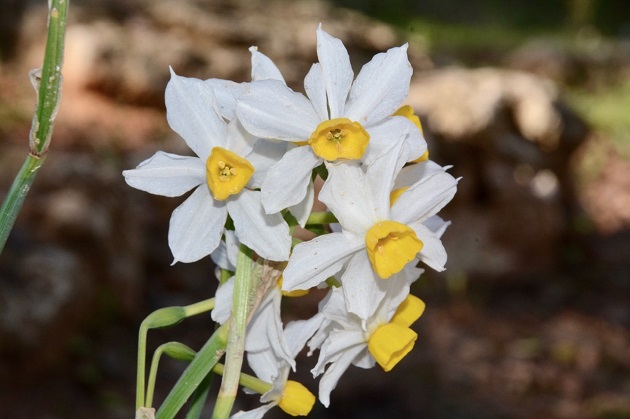The flower of the field
Many commentators believe this to be the flower that Solomon referred to as “the lily of the valley” in the Song of Songs.
25 AUGUST 2019 · 11:00 CET

The Hebrew term péraj, refers to flowers in general, rather than to any specific species.
The Holy Land boasts more than 2000 different species of such flowers. However, the concept of the “flower of the field” (khabbacceleth), as it appears in numerous verses in the Bible (Psalm 103 v 15; Isaiah 40 v 6; Job 14 v 2; etc.) is associated with the Arabic term beseil, the word used by Palestinians to refer to the bunch-flowered daffodil (Narcissus tazetta), which blossoms abundantly in the fields of Israel between November and January.
The Jews refer to this type of daffodil as “narkiss matzuy”. It is a small perennial plant, a member of the Amaryllidaceae family, which reaches a height of 30 cm and gives off a very pleasant fragrance.
It grows among the undergrowth in fertile, humid regions, on riverbanks and in mountainous areas. Many commentators believe this to be the flower that Solomon referred to as “the lily of the valley” in the Song of Songs (2 v 1). [1]
The English cleric and botanist Henry Baker Tristram (1822-1906) mentions the Narcissus tazetta in his list of possible candidates for the term “lily of the valleys”. [2]
Flowers feature in the Bible as decorative elements (Ex. 25:31ss; 37:17; 1 R. 7:26) as different species of them were portrayed by the sculptors on the pillar capitals in Solomon’s temple.
But they are also used to illustrate certain existential truths, such as the brevity of human life (Job 14 v 2; Psalm 103 v 15; Isaiah 5 v 24; 28 v 1; 40 v 6; Nahum 1 v 4; James 1 v 10; I Peter 1 v 24) or to reflect God’s providential care for his children (Matthew 6 v 28; Like 12 v 27).
The prophet Hosea also states that Israel will blossom like the lilies (Hosea 14 v 5).
In his commentary on Psalm 90, Spurgeon writes the following reflection:
“The scythe ends the blossoming of the field flowers, and the dews at flight weep their fall. Here is the history of the grass—sown, grown, blown, mown, gone; and the history of man is not much more. Natural decay would put an end both to us and the grass in due time; few, however, are left to experience the full result of age, for death comes with his scythe, and removes our life in the midst of its verdure. How great a change in how short a time! The morning saw the blooming, and the evening sees the withering”. [3]
[1] Alon, A. 1995, Flowers and Trees of the Holy Land, Palphot, Israel, p. 31.
[2] Tristram, H. B. 1883, The Natural History of the Bible, London, p. 463.
[3] Spurgeon, C. H. http://www.romans45.org/spurgeon/treasury/ps090.htm
Published in: Evangelical Focus - Zoe - The flower of the field
